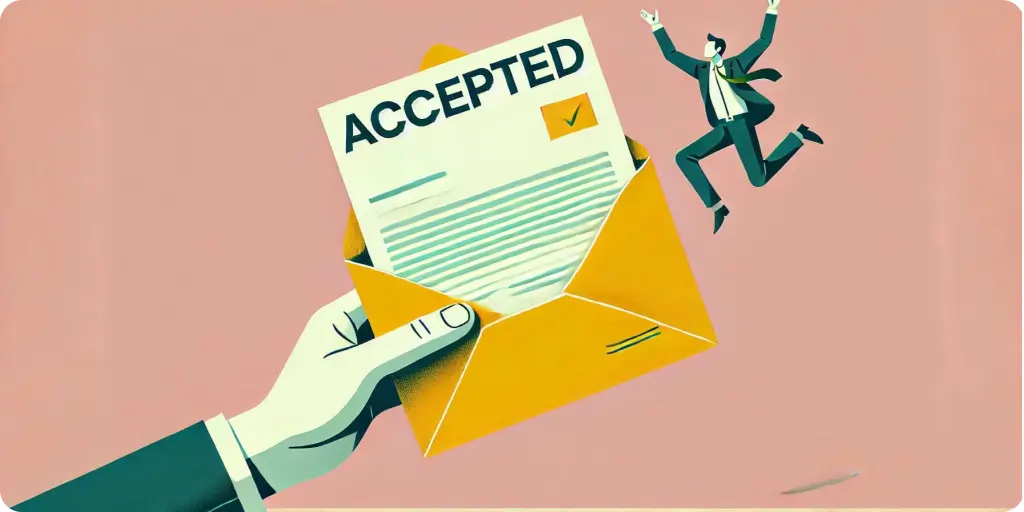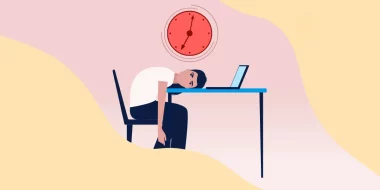Congratulations! After fine-tuning your resume and going through all those job interview rounds, you finally made it! But now comes the big question: how to accept a job offer email?
Accepting a job offer might seem like the last and easiest step to landing your dream job. But it’s not the time to relax just yet.
Because there’s a right way to do it that can leave a great impression.
And plenty of ways to mess it up.
But don't sweat it — we're here to walk you through every step from reading through the offer to hitting 'send' on your acceptance email. Plus, we'll even show you some practical tips and handy email templates to make it easier for you.
5 Job acceptance email templates to download
Let's start with 5 effective examples of how to accept a job offer via email.
While the first two templates are perfect for accepting the job offer immediately, the other three address any minor complications that might arise. So, you could be prepared for anything. ;)
Do you like any of them? In that case, feel free to click on the red button and download a version you can adjust to your liking.
#1 How to accept a job offer email template
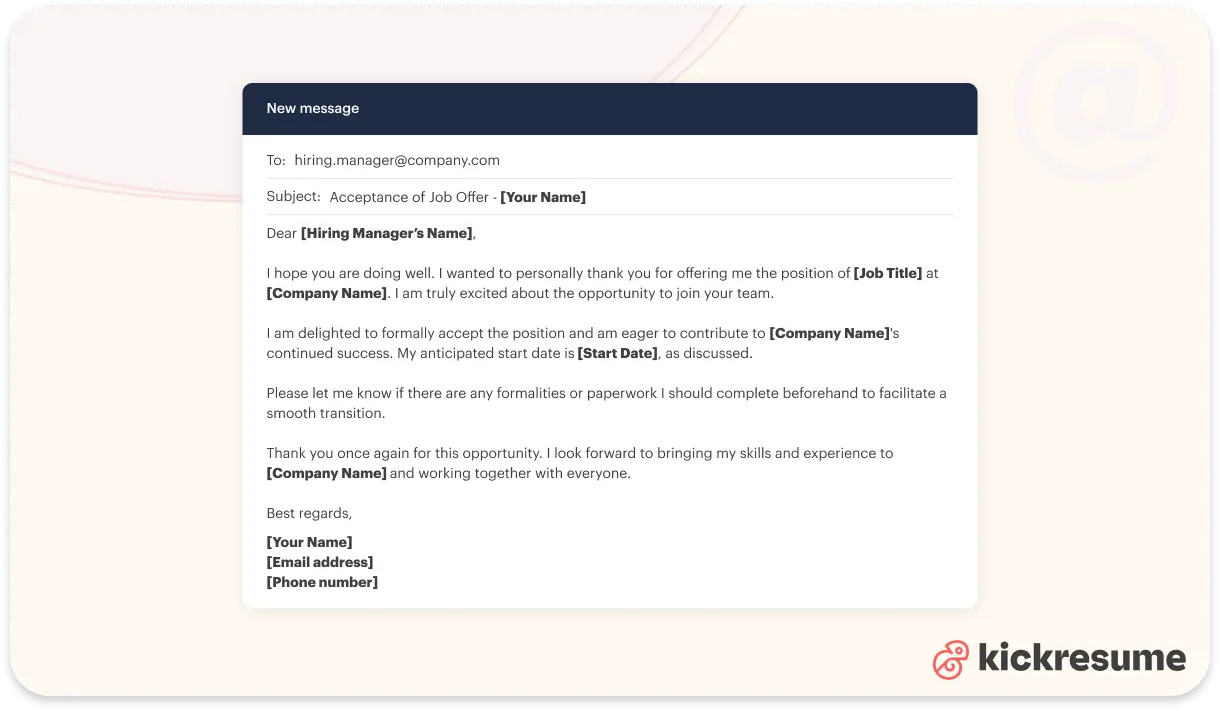
#2 How to accept a job offer email template
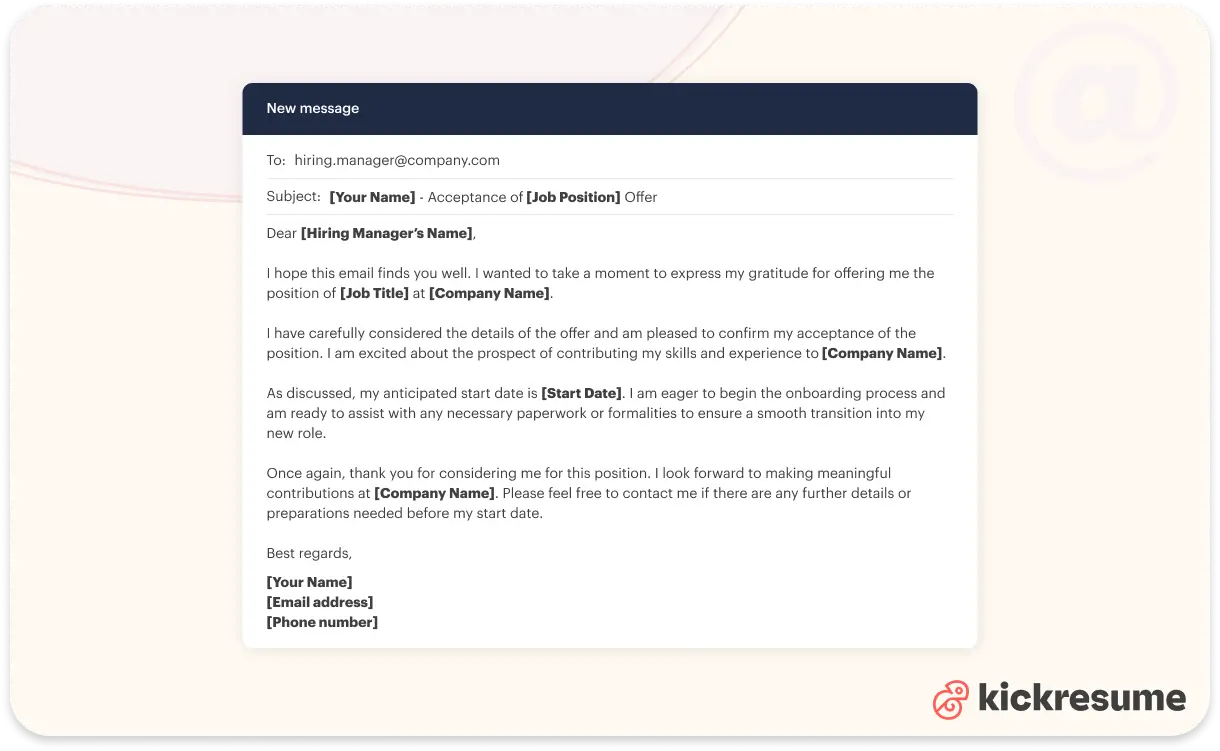
#3 How to accept a job offer email template: asking for an employment contract
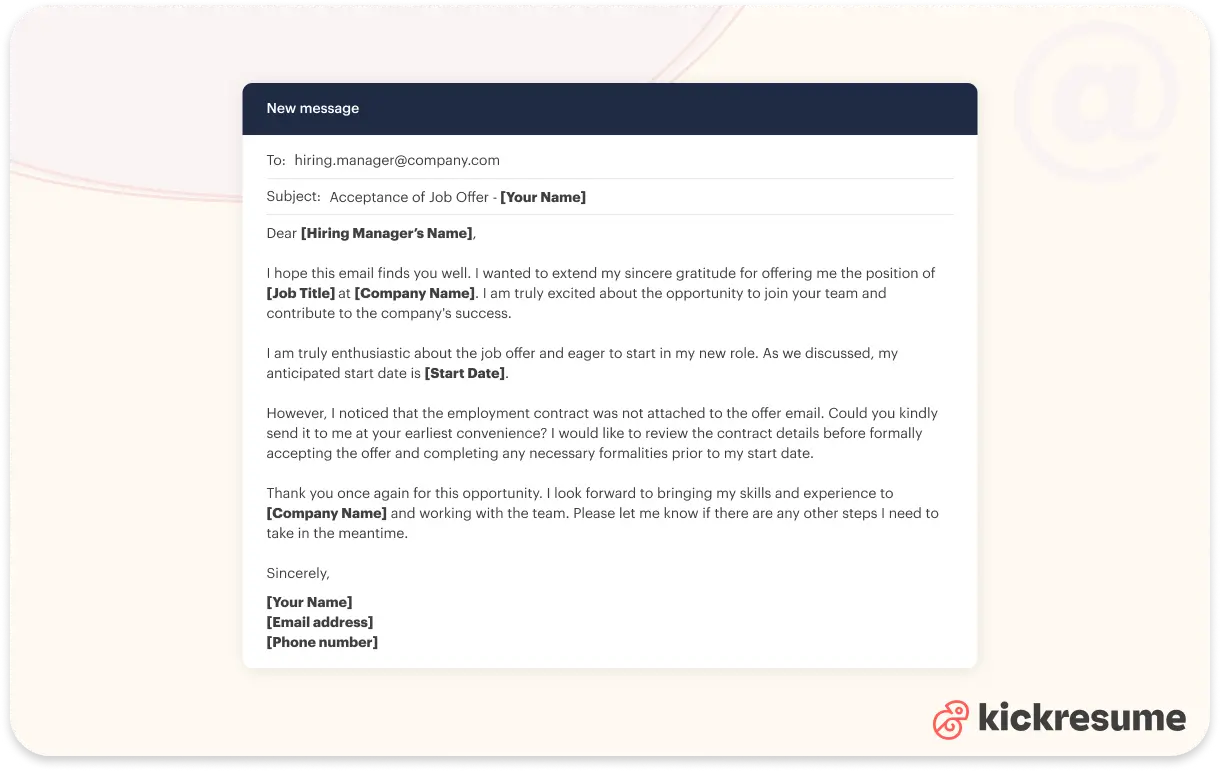
#4 How to accept a job offer email template: asking for a preferred date
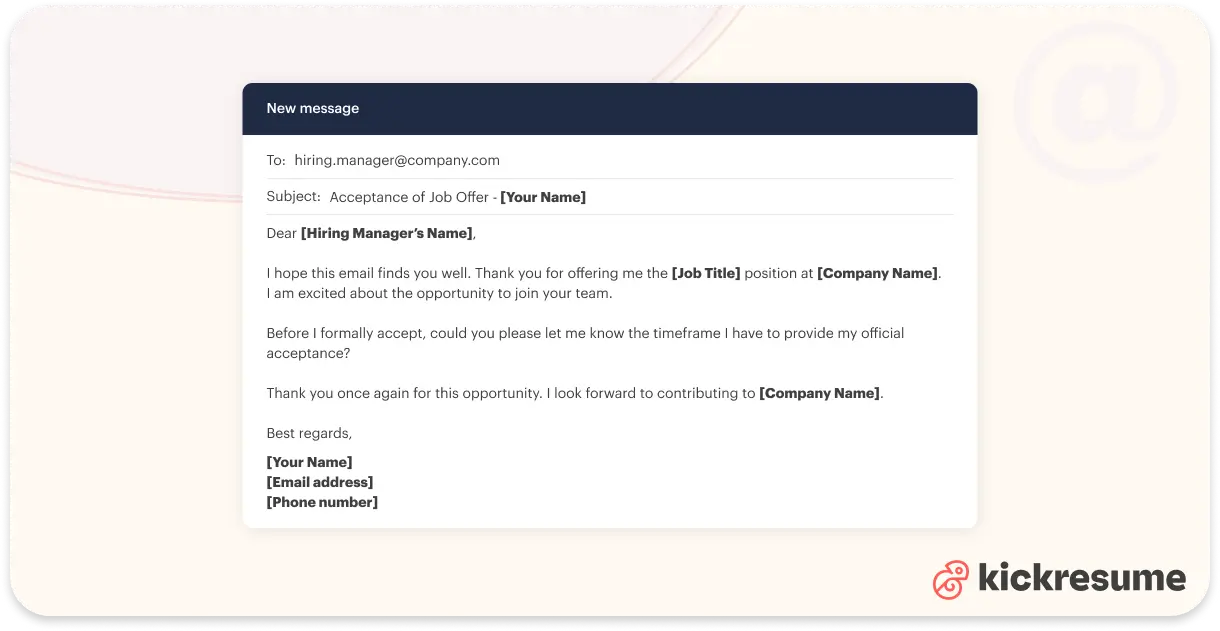
#5 How to accept a job offer email template: if you find inconsistencies
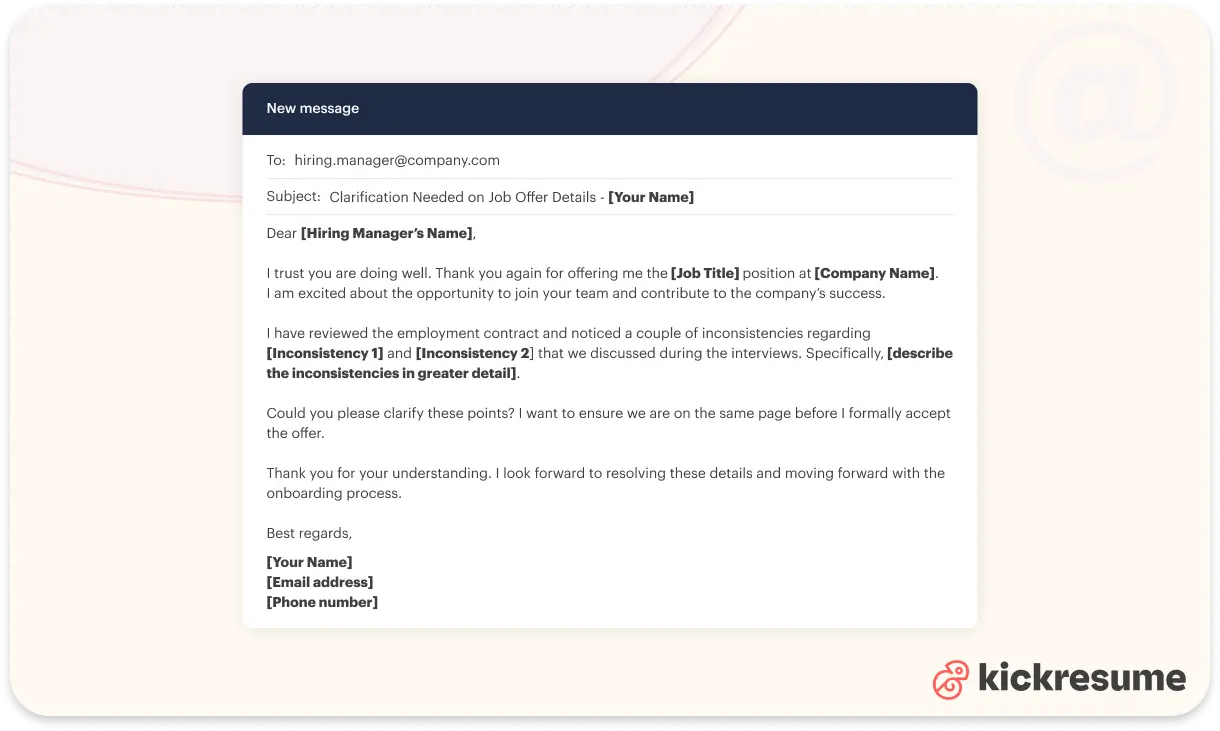
Now, let's talk about all the important details regarding job offers to make sure you don't do anything you might regret later.
What you need to know about job offers
Before we show you how to accept a job offer email, we need to make a few things clear:
- It can take time to hear back from the hiring manager. Don't expect the job offer to land in your inbox as soon as you leave the job interview. Sometimes, it can take a week. Or two. Or even three. After all, employers also need the time to consider all their options.
- Not all job offers arrive in the form of an email. It's not uncommon to receive a verbal offer through a phone call first. Employers like to do this because it adds extra personal touch to the whole process. And it's also much faster than typing out a formal email.
- It's always better to have everything written down. But even if you receive an offer over the phone, make sure to ask the hiring manager to email you anyway. This way, you have a record of what was discussed and can refer back to it if needed. Plus, it helps keep everyone on the same page.
- Lastly, you don't have to accept right away. And when you get that offer, take your time. You don’t have to say yes right on the spot. It’s okay to ask for a day or two to think it over. And if an employer pressures you to make a final decision over the phone, consider it a red flag!
These points are a solid introduction to job acceptance etiquette. While they might seem obvious to you, not everyone is familiar with them.
Whether you're starting your first job or making a significant career change, you should know what's acceptable and what's not.
Before you respond to a job acceptance email
So, you've talked to the hiring manager on the phone. Now, you're sitting behind your computer, waiting for a formal job offer. And then, finally, it arrives!
But what's next?
Before you start typing your response, breeze through these 4 tips — they can save you from any potential headaches:
- Read the offer thoroughly. Firstly, start by reading the offer carefully. Sometimes the job details are right there in the email itself, or they might be attached as a formal letter or an employment contract. In any case, you need to understand exactly what they're offering you — salary, benefits, start date, all that good stuff.
- Look for any discrepancies. Then, you'll have to double check if what they're offering matches what you talked about during your interviews. For example, the job description and responsibilities — look out for any surprises or differences. If something doesn't seem right or if you expected something else, now's the time to ask questions!
- Check for a preferred response date. Also, see if they've given you a deadline to respond. Some offers might say they need to hear from you by a certain date. But if there's no specific deadline, it's okay to reach out and ask when they'd like to get your decision. Plus, this shows you're serious and respectful of their time.
- Write your acceptance email. Finally, once you've reviewed everything and you're happy with the offer, it's time to write your job acceptance email. Keep it friendly but professional. Below, we've prepared a breakdown of elements that shouldn't be missing from your job acceptance response.
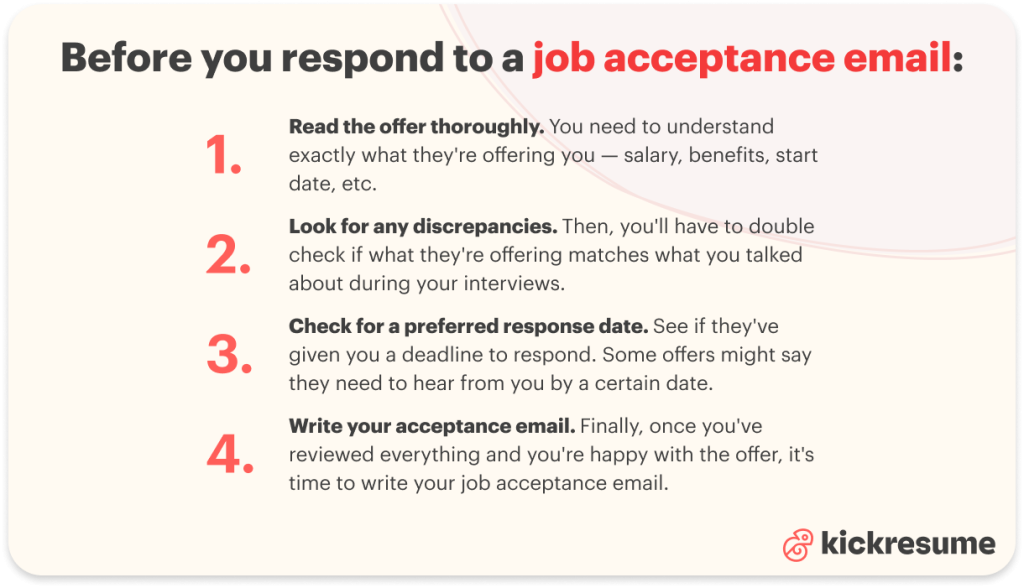
How to accept a job offer email in 7 steps
If you’re scratching your head trying to figure out how to write an email to accept a job offer, perk up your ears! We'll be breaking it down step by step to make it real easy.
You can craft a professional job acceptance email in these 7 steps:
- Create a suitable subject line.
The recipient of your email should be able to tell what the email is about as soon as they see it in their inbox. So, you need to keep the subject line concise and to the point.
- Start with an appropriate greeting.
The best way to greet is by addressing the recipient of your letter directly by their name.
- Express your gratitude.
Regardless of whether you'll accept the job offer or not, you always need to communicate that you're grateful for the opportunity. Once again, in the professional world, politeness and respect are both highly valued.
- State your acceptance.
Next, you need to express your position in a way that's clear and indisputable. So, instead of dancing around the subject, state your decision bluntly. Avoid any vagueness that could cause you problems down the line.
- Confirm (or contest) the job details.
Another crucial element of your job acceptance email is the part where you agree (or disagree) with the terms and conditions stated in the job offer. Because once you formally agree to an employment contract without bringing up any issues you might have with it, there's little you can do afterwards.
- Offer opportunity for discussing next steps.
How you end your email matters just as much as how you start it! Once you've accepted the job offer, you need to keep the conversation going. At this point, you should be the one keeping the discussion going ─ so, make sure you invite suggestions for scheduling a meeting or call to discuss your role and next steps.
- End with a professional sign-off.
Finally, close your email with yet another show of respect and politeness. No need to get experimental here ─ go for the classic: “Best regards/Sincerely [Your Name].”
And now, let's take a closer look at each of them!
Step 1: Create a suitable subject line
Even though the subject line of your email represents only a small part of the message, it deserves your full attention.
Why? Well, it's the very first thing the hiring manager sees! They're busy people who are bombarded by hundreds of emails daily. So, why not make their lives a bit easier by keeping your subject line clear and to the point?
If you're sending your reply as part of a continuous email thread, you don't need to fret (Former English lit student, can you tell?). But in case you're starting a fresh line of communication, format your subject line like this:
- Job Offer Acceptance - [Your Name]
- [Your Name] - Acceptance of [Job Position] Offer
Step 2: Start with an appropriate greeting
No need to spend too many words here. After all the job interview rounds you should know the name of the hiring manager. If you don't, well, shame on you!
For example, you can address your email like so:
- Dear [First Name] [Last Name]
- Dear Mr./Mrs. [Last Name]
It's classic, professional, and effective!
Step 3: Express your gratitude
The first thing you need to do is thank the hiring manager for the offer. This is the alpha and omega of how to accept a job offer via email!
But don't overdo it please. Of course, your enthusiasm should be genuine and palpable. But it also needs to be believable and classy.
So, instead of “Thanks man, this is the best day of my life!”, try something more tame. For example:
- “Thank you for the offer to join your team as a [Job Position Title]. I am genuinely excited about this opportunity and look forward to contributing to the company.”
- “Thank you so much for offering me the position of [Job Position Title]. I am truly grateful for this opportunity.”
And a little side note: stating the name of the job position in the opening paragraph helps with clarity!
Step 4: State your acceptance
Despite your clear and genuine enthusiasm, you should definitely state the obvious!
In this way, you'll avoid any possible misunderstandings. So, make sure you don't leave any room for interpretation.
Make your position clear and indisputable, like so:
- "I am pleased to formally accept the position."
- “I am honored and excited to accept the position of [Job Position Title] at [Company Name].”
Step 5: Confirm (or contest) the job details
After expressing your acceptance of the job offer, it’s a good idea to confirm the key details discussed during the hiring process.
You'll ensure that both you and the employer are on the same page regarding important aspects of the job.
In case the job offer email came with an official employment contract, you'll be able to review all the details. But if the contract isn't attached, simply ask for it. Politely, of course!
Either way, it's good to mention at least some of the stipulations directly in your job acceptance email. These could include:
- start date,
- salary,
- benefits,
- or even work location.
For example, you could type something like this:
- “As discussed, my start date will be on August 15th, 2024.”
- "I recall our discussion about the hybrid work arrangement. Could you confirm the days I will be expected to work from the office?
If you notice any discrepancies between what you've discussed and what you're being offered right now, point them out here before agreeing to anything (scroll to our templates to see how it's done).
Step 6: Offer opportunity for discussing next steps
The point of the closing paragraph is to leave a positive and proactive impression on the hiring manager! That's why you should mention:
- your enthusiasm (yes, again!),
- your readiness for the next steps,
- and your availability.
For example, you could end your email like this:
- "I cannot wait to start and meet the team. Please let me know if there are any forms or information needed before my start date."
- "I look forward to starting the onboarding process. Let me know if there are any additional steps I should take before my start date."
Step 7: End with a professional signoff
And now, all you need to do is end your email with a professional closing. No need to get experimental here ─ go for the classic: “Best regards/Sincerely [Your Name].”
Don't forget to also mention your contact details:
- phone number,
- email address,
- link to your LinkedIn profile.
Is it necessary? No. But is it polite and expected? Absolutely!
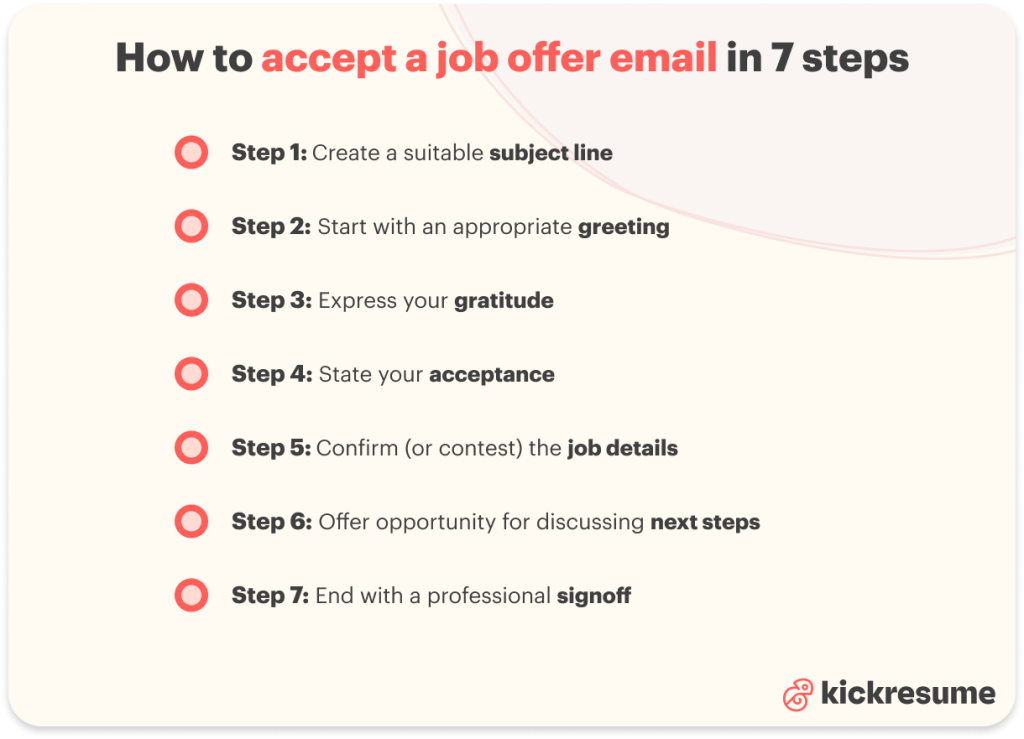
More tips on how to properly accept a job offer email
Since there's always room for good advice, we've put together some essential tips to make sure your job acceptance email always hits the mark:
- Use a professional email address. First of all, avoid using overly casual or personal addresses. So, that email address you set up in 2007 (cooldude123@gmail.com, probably) has to go!
- Respect the response time. Also, it's important to stick to the timeline the employer gave you. This shows you're organized and respectful. Plus, it keeps things moving smoothly so everyone knows what to expect.
- Proofread, proofread, proofread! Spelling errors, typos, and other unnecessary mistakes can make you look careless. So, take the time to proofread your email thoroughly. You can read it out loud, use spell check, or ask a friend to review it for you.
- Test send the email to yourself. Before sending your acceptance email to the employer, send a test email to yourself. That way, you'll see how the email actually looks in your inbox. And then, you can correct any formatting issues or overlooked errors.
If you think about it, your job acceptance email is the very last thing you need to do to finally get the job you wanted for so long. In a way, it's like turning the final page of one chapter and opening another. So, make it count!
Key takeaways: How to accept a job offer email
A job acceptance email is your formal agreement to the terms and conditions outlined by your future employer.
But it's more than just a formality! This step sets the tone for your professional relationship and demonstrates your enthusiasm for the role.
Moreover, knowing how to accept a job offer via email allows you to confirm or discuss the terms of your employment. For example, terms pertaining to the job responsibilities, salary, start date, and other important details.
And when you're putting together you job acceptance email, don't forget to include these 7 elements:
- Suitable subject line
- Appropriate greeting
- Expression of gratitude
- Stating your acceptance
- Confirmation of job details
- Discussing next steps
- Professional signoff
So, go ahead, take a deep breath, and craft that perfect job acceptance email. And if you ever need a bit of guidance, don’t forget to refer back to our handy templates.
But what if you decided not to take the job offer? Well, in that case, don't miss out on the chance to learn how to turn down a job offer but keep the door open.
